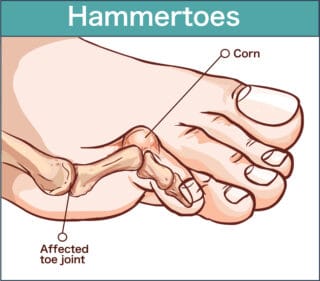
More Podiatry Foot Care Articles
Hammertoes

What Is a Hammertoe?
A hammertoe is a contracture – or bending – of the toe at the first joint of the digit, called the proximal interphalangeal joint. This bending causes the toe to appear like an upside-down V when looked at from the side. Any toe can be involved, but the condition usually affects the second through fifth toes, known as the lesser digits.
There are two different types:
Flexible Hammertoes
These are less serious because they can be diagnosed and treated while still in the developmental stage. They are called flexible hammertoes because they are still moveable at the joint.
Rigid Hammertoes
This variety is more developed and more serious than the flexible condition. Rigid hammertoes can be seen in patients with severe arthritis, for example, or in patients who wait too long to seek professional treatment. The tendons in a rigid hammertoe have become tight, and the joint misaligned and immobile, making surgery the usual course of treatment.
Symptoms
- Pain upon pressure at the top of the bent toe from footwear.
- The formation of corns on the top of the joint.
- Redness and swelling at the joint contracture.
- Restricted or painful motion of the toe joint.
- Pain in the ball of the foot at the base of the affected toe.
How Do You Get a Hammertoe?
A hammertoe is formed due to an abnormal balance of the muscles in the toes. This causes increased pressures on the tendons and joints of the toe, leading to its contracture.
What Can You Do For Relief?
- Apply a commercial, non-medicated hammertoe pad around the bony prominence of the hammertoe. This will decrease pressure on the area.
- Wear a shoe with a deep toe box.
- If the hammertoe becomes inflamed and painful, apply ice packs several times a day to reduce swelling.
- Avoid heels
- A loose-fitting pair of shoes can also help protect the foot while reducing pressure on the affected toe.
See your physician if pain persists.


















